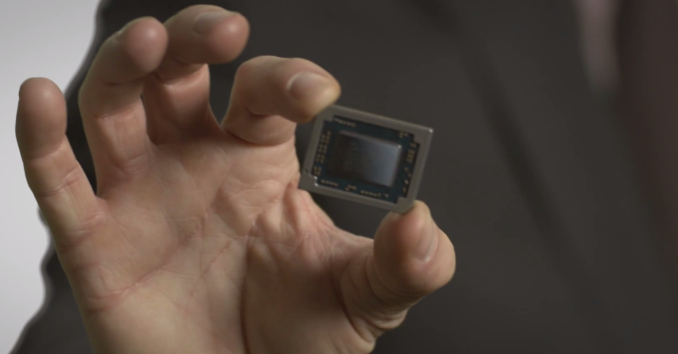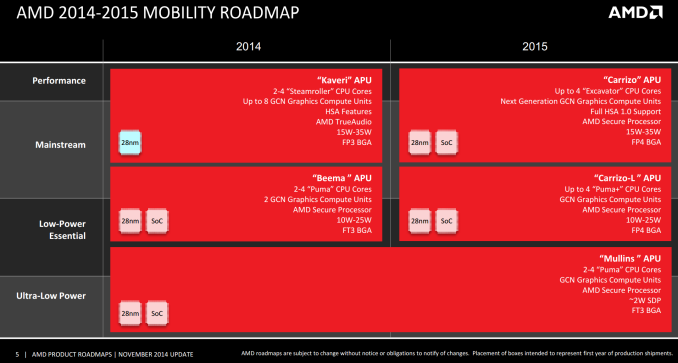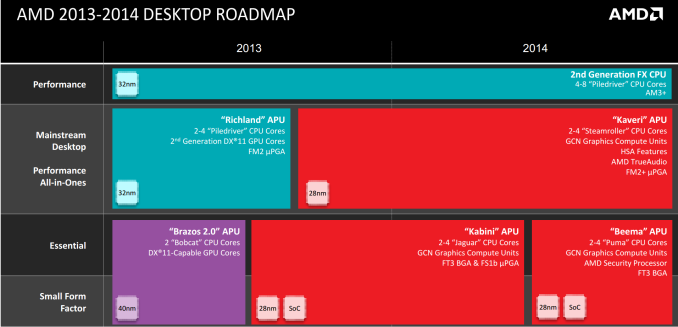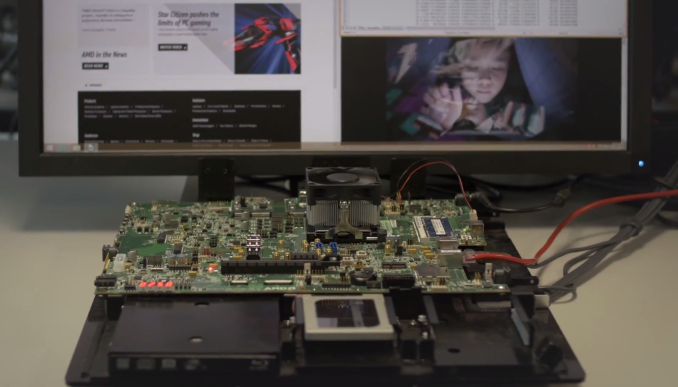AMD’s Carrizo not on the Desktop? Depends What You Define as Desktop
by Ian Cutress on January 13, 2015 5:20 AM EST
We reported on AMD’s next iteration of their Bulldozer architecture, code named Excavator, during the press release regarding their next processor line up called Carrizo. At the time, the focus for Carrizo (and Carrizo-L) was aimed at notebooks and laptops, with the road-map from AMD on 2015 looking at 15-35W BGA parts in the performance and mainstream. Carrizo-L specifically took Puma+ cores, from the Cat family of cores, down to 10-25W, with Mullins running the ultra-low-power market at 2W. All of these being full SoCs, and soldered down BGA packages. The feeling at the time was that Carrizo would be a mobile focused launch, with the potential for desktop to be examined at a later date as AMD takes pride in owning the desktop integrated graphics title with Kaveri, and AMD would need something to compete against the upcoming Broadwell as well as Skylake in 2015.
However, in our periphery we noted The Tech Report come out and categorically state that ‘Carrizo will face off with Broadwell-U, won’t land in desktops’. The first part of that is definitely true, with Carrizo’s 15W-35W range synchronizing nicely with Broadwell-U’s 15W-28W parts, however the second part of it is somewhat new. Up until this point, AMD had neither confirmed nor denied (in true CIA style) about the future of their desktop landscape, to the point that their desktop roadmap stopped at 2014:
The Tech Report mentions a single line to the claim: ‘AMD has no plans to offer Carrizo as a socketed chip for desktop PCs’. We reached out to AMD for some form of confirmation or explanation as to this line, because it felt kind of odd. With a well-positioned launch, with enough SKUs in enough markets to cater up and down the price range, AMD could re-launch the APU line with the latest architecture updates for the better. We received the following response from AMD’s James Prior:
“With regards to your specific question, we expect Carrizo will be seen in BGA form factor desktops designs from our OEM partners. The Carrizo project was focused on thermally constrained form factors, which is where you'll see the big differences in performance and other experiences that consumers value.”
There’s no direct denial of socketed Carrizo based parts here, but all arrows point to BGA desktops, such as all-in-ones and mini-PCs (the high-end segment for Broadwell-U). We have seen at least one socketed part, when AMD launched its Carrizo video:
But this was labelled as a pure engineering sample when we saw it at AMD’s suite at CES. So while we can’t confirm the ‘no plans’ part from TR’s quote, Carrizo as a socketed part for desktops is currently not public knowledge as of yet. AMD is in a quiet period right now and not wanting to rock the boat from what is currently on the market by announcing anything on the desktop side. This is despite AMD’s list of features being a prominent slide in their Carrizo slide deck, most of which would be important parts within a desktop environment.
If AMD is planning no further socketed desktop APUs from the base-Bulldozer architecture, we would have to head towards Jim Keller's team and K12/Zen in 2016 as the next port of call, despite that platform currently being touted more for low power, servers and embedded right now. Part of me wants to believe we won’t have to wait that long, given that Kaveri first appeared in January 2014 at it would mark a two-to-three year gap on the desktop side. Even AMD would have a hard time explaining that one, unless it made financial sense overall.














34 Comments
View All Comments
dragosmp - Tuesday, January 13, 2015 - link
Ian, this article makes more sense considering the limited information available.Any speculation what this means for AM1? It seems there would be a superior "Puma+" core available for this type of CPU, but would an updated AM1+ platform be released?
R3MF - Tuesday, January 13, 2015 - link
... unless they plan to warm over kaveri to keep fm2+ alive for the desktop.maybe create a six core part with 384 shaders, or an eight core with 256 shaders.
yannigr2 - Tuesday, January 13, 2015 - link
They did announced 7650K which could become a best seller having a good price ($105) configurable TDP AND unlocked multiplier. They could come out with more unlock models in 2015 and nothing more. There are still just too many Richlands and even Trinitys in the market.dragosmp - Tuesday, January 13, 2015 - link
The 7650K does seem a nice CPU, but it's too power hungry and expensive for someone who would be fine with an AM1.Example: 90$ would buy you a 5350 and an Asus AM1i-A whith which can OC the 5350 to something like 2.4-2.8GHz. 4 high IPC cores @2.8GHz are fast especially together with SSDs and enough RAM. This platform looks crazy good as it is, but is there an update around the corner?
Side question - is a 3.5GHz Kaveri a reasonable alternative to a 2.8GHz Puma? Consider: Puma has 4 real cores (4xFPU), even OCed consumes 1/3 of the Kaveri and Puma has higher IPC. Seems like the days when Intel's mobile Core Duo was faster in almost all (non-FP) tasks than the P4-D while consuming 3x less and wondering why didn't they just replace Prescott with Conroe...
Shadowmaster625 - Tuesday, January 13, 2015 - link
I dont know where this "high IPC" meme is coming from, but a 5350 takes more than twice as long to complete a sunspider test, compared to a kaveri core which is clocked less than twice as fast.silverblue - Tuesday, January 13, 2015 - link
Not to mention the single channel memory interface, half speed cache, and the fact that Kaveri theoretically equals Puma+ per clock for FP output (as far as I'm aware - two FlexFPUs means 4x128-bit units, precisely the same as Phenom II X4 and Puma+ quad). Let's not forget that most Puma+ products don't have a Turbo implementation, either.SaberKOG91 - Tuesday, January 13, 2015 - link
I would expect Skybridge to be the target for AM1 upgrades. Low power and flexibility are two of the focuses of the Skybridge ARM K12 / X86 Puma+ hybrid socket. This seems to follow AMD's direction of momentum.gostan - Tuesday, January 13, 2015 - link
no matter how they spin it, AMD has no chance in any profitable thermally constrained form factors. simple as that. their chips will go in to very entry level thermally constrained form factors, which aren't going to make them any money.so "Carrizo’s 15W-35W range synchronizing nicely with Broadwell-U’s 15W-28W parts" isnt exactly the correct sentence to say. VIA can do 15w too but the performance is gonna suck. heck any 'desktop class' ARM is below 20w.
we have heard this tune by AMD before. when you cant compete you go mysterious, and AMD has been repeating this trick for many years.
SaberKOG91 - Tuesday, January 13, 2015 - link
AMD is all about the whole user experience. Most consumers (non-gamers) don't need very much in the way of CPU power. A 2+ GHz dual or quad will meet the majority need. This, paired with AMD's professional grade graphics, is meant to allow for a fluid user experience. By being lower power, AMD can bring this experience to mainstream laptop and all-in-one designs.However, the market segment to watch is business machines. Systems powered by Carrizo should be more than sufficient for the majority of office tasks, including graphic design. These chips are spec'd high enough to handle basic 3D modelling in SolidWorks and the like. You might need to do final renders elsewhere, but it should also be fast enough to do 3D animation for video applications. They also make excellent thin clients for Citrix HDX or Microsoft RemoteFX capable environments. My company was doing this dating back to the E350 days and have steadily upgraded as better hardware has come online.
Another important place that these chips (particularly Carrizo-L) will find their niche is in Digital Signage. I'm not sure you understand how big of a deal it is that AMD has low power chips that can drive multiple displays using UVD to decode HEVC 4K at 60fps. To my knowledge, they are the first non-FPGA design to do HEVC decoding without an off-chip co-processor. AMD APUs have been deployed all over for electronic billboards and shopping displays.
takeship - Tuesday, January 13, 2015 - link
A 2+ GHz dual would be quite a stretch for AMD in a thermally limited form factor, a quad core is pretty much out of the running. I notice that AMD lists Mullins above as a 2014-2015 era chip, but did they have even a single design win? Beema sure, but then that's a bigger power envelope. Speaking of which, there's a bit of quiet revisionism going on in that slide. Per wikipedia, Mullins debuted as a 4W chip, with NO 2W varients.